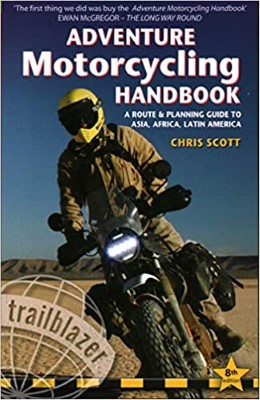 |
|

23 Aug 2002
|
|
Registered Users
New on the HUBB
|
|
Join Date: Jul 2002
Location: switzerland
Posts: 8
|
|
|
how cold?
hi again
everyone says it gets cold at night in the desert. sure, but how cold?
i will be there in late september/early october and sleeping in a tent. i can't decide whether to take a sleeping bag. i am thinking that a woollen or synthetic blanket bought in a market (plus wearing some warm clothes if necessary) would be sufficient. what do you think?
thank you for any advice
paul
|

23 Aug 2002
|
|
Registered Users
HUBB regular
|
|
Join Date: Aug 2002
Location: Bialystok, Poland
Posts: 89
|
|
|
I was in Niger/Chad year ago about November. I've slept on the desert in Air Mountains and light sleeping bag together with warm blouse/sweater was ok.
I had bad experience with open truck rides overnight. It was so cold (mainly due to constant cool air flow) that putting everything I had was not enough (local guy in t-shirt next to me was not complaining although). It was really bad but good windstopper (I didn't have one) should do the job.
|

23 Aug 2002
|
|
Registered Users
Veteran HUBBer
|
|
Join Date: Mar 2001
Posts: 921
|
|
|
Take a roll-mat - you lose more heat to the ground than to the air so you need to insulate beneath you. A woolly hat will also keep in a lot of heat.
Other than that, in a tent you should be fine.
Sam.
PS Rather than a tent, why don't you take a tarp - half the weight/cost and a fraction of the time to put up, ie during the day for a spot of shade whilst waiting for a lift?
|

24 Aug 2002
|
|
Registered Users
Veteran HUBBer
|
|
Join Date: Aug 2002
Location: Vojvodina, Serbia&Montenegro
Posts: 125
|
|
|
hi all!
What are the temperatures in desert,dayly hi and night low,in degrees celsius?
Not avrage temp's!
cheers!
__________________
cheers
jondoe
|

24 Aug 2002
|
|
Registered Users
Veteran HUBBer
|
|
Join Date: Mar 2001
Posts: 921
|
|
|
August, +42C at 2pm, +20C at dawn
January, +30 at 2pm, +5 at dawn
Ambient, no wind chill.
Up or down by 5C variation due to weather/wind direction etc....
Occasional extremes in excess of these figures. Altitude will reduce these temperatures by 1.5C per 1000ft (300m).
Sam.
|

25 Aug 2002
|
|
Registered Users
Veteran HUBBer
|
|
Join Date: Apr 2000
Posts: 281
|
|
|
|

25 Aug 2002
|
|
Registered Users
Veteran HUBBer
|
|
Join Date: Mar 2001
Posts: 921
|
|
|
Sula,
That's a great website!
Also disperses the 'it's too hot to live' argument against travelling in August...
Sam.
PS Also glad to see that my figures are not too far out!
|

25 Aug 2002
|
|
Registered Users
Veteran HUBBer
|
|
Join Date: Aug 2001
Location: Dubai
Posts: 192
|
|
|
Sam not trying to be picky or anything, just for your future reference, temperature drops at 1.98 degs C for every 1000ft of altitude.
Col Campbell
__________________
An aussie escaped from london, now in Dubai.
|

26 Aug 2002
|
|
Registered Users
Veteran HUBBer
|
|
Join Date: Mar 2001
Posts: 921
|
|
|
The Environmental Lapse Rate is taken as 1.98C per 1000ft.
Saturated ('SALR' is 1.5C per 1000ft), and more interestingly for the region in question, the DALR (Dry Adiabatic Lapse Rate) is 3C per 1000ft.
I remembered them being the other way around, we are looking at the DALR, thus 3C per 1000ft.
It's amazing what stuff (mostly) sticks during flight school!
Sam.
|

27 Aug 2002
|
|
Registered Users
HUBB regular
|
|
Join Date: May 2001
Location: Lindfield, West Sussex, England
Posts: 92
|
|
With regard to high temperatures, temperature isn’t the whole story. Relative Humidity must be taken into account as well. As the Relative Humidity increases, the air surrounding your body is less able to absorb your sweat. This means that your body cooling becomes less effective.
In the US they use the Heat Index, which is the temperature that your body feels when heat and humidity are combined. The formula is about 40cm long, and there seems to be different versions of it.
At 35°C with 20% Relative Humidity, the Heat Index is 33, ie it feels like 33°C - cooler than it actually is. But with 80% Relative Humidity, the Heat Index climbs to 56.7 - past the danger point of 54°C where heatstroke becomes highly likely with continued exposure.
In the Sahara we have very low Relative Humidity, but as you move South things change. In August Nema has a maximum temperature of 36°C with a Relative Humidity of 59%, which gives it a Heat Index of 47.8. This would be classified as hazardous/dangerous in the US (Sunstroke, muscle cramps, and/or heat exhaustion likely. Heatstroke possible with prolonged exposure and/or physical activity.).
With regard to low temperature, again temperature isn’t the full story. You need to take the Wind Chill factor into account.
A good website with calculators for the Heat Index and Wind Chill factor can be found here: http://www.wrh.noaa.gov/Glasgow/calculator.shtml.
From personal experience I can tell you that I’ve woken up in the morning with frost on the outside of my tent. That was on New Year’s Day in the Saudi desert.
|

27 Aug 2002
|
|
Registered Users
Veteran HUBBer
|
|
Join Date: Jul 2001
Location: France and UK
Posts: 156
|
|
Thank you, Terry for that invaluable information – you are the great researcher of this forum!
Just to confuse everyone, the ‘sleeping bag factor’ is worth mentioning; the more you weigh, the less thermal insulation a sleeping bag provides.
At around 13 stone I have been compelled to discard my down-filled 40’ – 0’C bag and adopt an 40’ to –5’ bag.
This has proved considerably more effective in keeping out the night chill. I’m a pyjama freak and wouldn’t consider going to bed wrapped in heavy sweaters, socks and hat!
While the desert temperature may not drop below –5’ C (except possibly in the Atlas or Hoggar or Tibesti regions) wind chill factors should, as Terry observes, be considered.
Sleep well…
------------------
Kitmax - Traveller
Desert Pictures at
http://www.kitmax.com/kitmax/kit03ph...velgallery.htm
homepage http://www.kitmax.com
__________________
Kitmax
|

27 Aug 2002
|
|
Registered Users
Veteran HUBBer
|
|
Join Date: Aug 2001
Location: Dubai
Posts: 192
|
|
|
Well Sam you learn something every day, during my apprenticeship I had 1.98 drilled into me, I had just taken this figure for granted, thanks for enlightening me.
Thats the best part of these forums, when a few ideas start to get thrown around everyone usually learns something.
Col Campbell
__________________
An aussie escaped from london, now in Dubai.
|

27 Aug 2002
|
|
Contributing Vendor
Veteran HUBBer
|
|
Join Date: Apr 2001
Location: Tallinn
Posts: 403
|
|
Is the 1.98 linear (for mountain altitudes), or rate varies with altitude ?
I was not aware of this figure, but had a perfect confirmation when we climbed Uweinat last november. Early afternoon high was around 30C in the valleys, yet on the peak it was only 22C at 1pm, perfectly matching the altitude diff of 4000 feet.
The coldest I ever experienced in the Eastern Sahara was 0C at dawn early december at the Gilf Kebir. Early/mid october it is unlikely to have anything below 8-10C, except at altitude.
------------------
Happy Travels,
Andras
FJ Expeditions
|

27 Aug 2002
|
|
Registered Users
Veteran HUBBer
|
|
Join Date: Mar 2001
Posts: 921
|
|
|
The rate doesn't change with altitude, except when changing from SALR through ELR to DALR as your altitude increases.
Clear??!!
Sam.
|
|
Currently Active Users Viewing This Thread: 1 (0 Registered Users and/or Members and 1 guests)
|
|
|
 Posting Rules
Posting Rules
|
You may not post new threads
You may not post replies
You may not post attachments
You may not edit your posts
HTML code is Off
|
|
|
|

Check the RAW segments; Grant, your HU host is on every month!
Episodes below to listen to while you, err, pretend to do something or other...

2020 Edition of Chris Scott's Adventure Motorcycling Handbook.
"Ultimate global guide for red-blooded bikers planning overseas exploration. Covers choice & preparation of best bike, shipping overseas, baggage design, riding techniques, travel health, visas, documentation, safety and useful addresses." Recommended. (Grant)

Ripcord Rescue Travel Insurance™ combines into a single integrated program the best evacuation and rescue with the premier travel insurance coverages designed for adventurers.
Led by special operations veterans, Stanford Medicine affiliated physicians, paramedics and other travel experts, Ripcord is perfect for adventure seekers, climbers, skiers, sports enthusiasts, hunters, international travelers, humanitarian efforts, expeditions and more.
Ripcord travel protection is now available for ALL nationalities, and travel is covered on motorcycles of all sizes!
What others say about HU...
"This site is the BIBLE for international bike travelers." Greg, Australia
"Thank you! The web site, The travels, The insight, The inspiration, Everything, just thanks." Colin, UK
"My friend and I are planning a trip from Singapore to England... We found (the HU) site invaluable as an aid to planning and have based a lot of our purchases (bikes, riding gear, etc.) on what we have learned from this site." Phil, Australia
"I for one always had an adventurous spirit, but you and Susan lit the fire for my trip and I'll be forever grateful for what you two do to inspire others to just do it." Brent, USA
"Your website is a mecca of valuable information and the (video) series is informative, entertaining, and inspiring!" Jennifer, Canada
"Your worldwide organisation and events are the Go To places to for all serious touring and aspiring touring bikers." Trevor, South Africa
"This is the answer to all my questions." Haydn, Australia
"Keep going the excellent work you are doing for Horizons Unlimited - I love it!" Thomas, Germany
Lots more comments here!

Diaries of a compulsive traveller
by Graham Field
Book, eBook, Audiobook
"A compelling, honest, inspiring and entertaining writing style with a built-in feel-good factor" Get them NOW from the authors' website and Amazon.com, Amazon.ca, Amazon.co.uk.
Back Road Map Books and Backroad GPS Maps for all of Canada - a must have!
New to Horizons Unlimited?
New to motorcycle travelling? New to the HU site? Confused? Too many options? It's really very simple - just 4 easy steps!
Horizons Unlimited was founded in 1997 by Grant and Susan Johnson following their journey around the world on a BMW R80G/S.
 Read more about Grant & Susan's story
Read more about Grant & Susan's story
Membership - help keep us going!
Horizons Unlimited is not a big multi-national company, just two people who love motorcycle travel and have grown what started as a hobby in 1997 into a full time job (usually 8-10 hours per day and 7 days a week) and a labour of love. To keep it going and a roof over our heads, we run events all over the world with the help of volunteers; we sell inspirational and informative DVDs; we have a few selected advertisers; and we make a small amount from memberships.
You don't have to be a Member to come to an HU meeting, access the website, or ask questions on the HUBB. What you get for your membership contribution is our sincere gratitude, good karma and knowing that you're helping to keep the motorcycle travel dream alive. Contributing Members and Gold Members do get additional features on the HUBB. Here's a list of all the Member benefits on the HUBB.
|
|
|